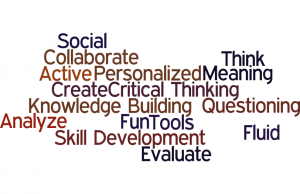The construction and necessity of knowledge is one of the most compelling issues in education today, in my opinion. What knowledge do we need to have? How much time should we devote or focus on knowledge versus skill development? Is knowledge synonymous with information? Do we have a universal understanding of knowledge? The rate at which information changes and the fluidity of knowledge has left structures and institutions burnt out and feeling disconnected in their attempts to maintain the interplay among knowledge in the TPACK (2006) framework. Yet still, the TPACK framework finds relevance among the halls and walls of 21st century schools.
Since this was not my first experience with the TPACK framework, I decided to refer to some additional resources. I came across a website and post by Matthew Koehler (2012). There he writes that “Effective technology integration for pedagogy around specific subject matter requires developing sensitivity to the dynamic, transactional relationship between these components of knowledge situated in unique contexts” (Koehler, 2012). This reminded me there are specific skills related to reading in each subject area that we must teach. I was involved in a provincial pilot project to implement Reading Apprenticeship, (https://readingapprenticeship.org/) which specifically teaches reading in content areas. Specifically, there are reading strategies and skills that scientists or mathematicians have and need to develop in order to be successful. Similar to this, the TPACK framework explains that there are technological content area requirements that teachers need to attune to in order to meet students’ needs.
Last year, a group of grade five and six students and I submitted an application to the Samsung Solve for Tomorrow challenge. It required the students to select a problem in their community and use STEM to solve it. After I submitted our application in the first round, we were 1 of 150 finalist in Canada who had the opportunity to turn our plan into actions! We also won some Samsung technology to help us out. My group of eight students attempted to build a dual garbage and recycling bin prototype to post in our school yard to clean up the litter. They also made a website to spread the message about cleaning up the environment.
I think this experience would have been better if I had used the TPACK framework more effectively and thought more about how scientists use the tools and technology to combine it with pedagogy. We didn’t think enough about how someone in a STEM field might build a garbage can; what materials would they use? How would they test it? What tools would they use? It is a good opportunity for me to reflect on how to improve my learning and teaching to enhance that of my students’.
Koehler, M. (2012). TPACK Explained. TPACK.ORG. Retrieved 3 February 2018, from http://matt-koehler.com/tpack2/tpack-explained/
MISHRA, P., & KOEHLER, M. (2006). Technological Pedagogical Content Knowledge: A Framework for Teacher Knowledge. Teachers College Record, 108(6), 1017-1054. http://dx.doi.org/10.1111/j.1467-9620.2006.00684.x
